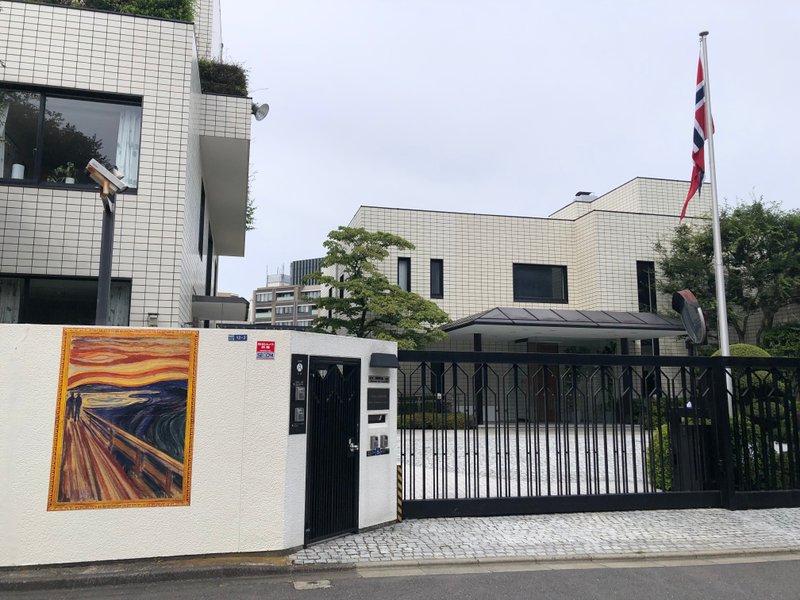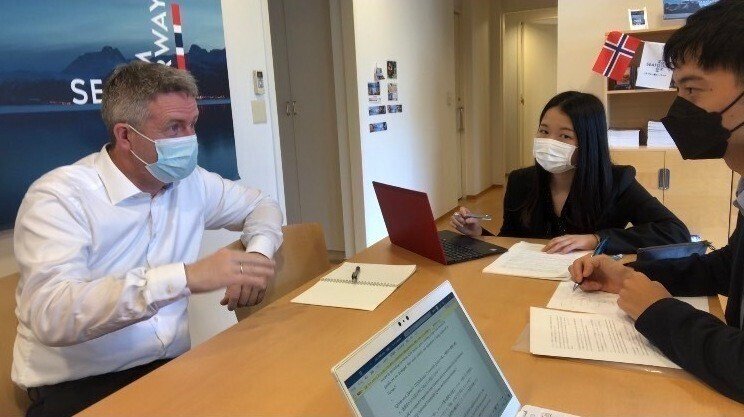こんにちは!
先日、海洋大生3人で、ノルウェー大使館にあるノルウェー水産物審議会を取材しました。
公式サイト:
https://seafoodfromnorway.jp/
日本担当ディレクターのヨハンさんに色々お話を聞き、水産大国・ノルウェーのサーモン(とサバ)養殖にの秘密について、今回の記事で書いていきたいと思います!
ノルウェーの徹底した養殖、すごかった…

それでは行ってみましょう!
Q. Every single salmon has a its own passport which enable us to track it back, and it has information of how and where the salmon has been processed, the quality grade, date of production, preservation, storage temperature or etc. We don’t get the chance to know that information of each fish here in Japan. Do people in Norway take it for granted?
(ノルウェーのサーモンはそれぞれにパスポートを持っており、それにより水揚げの日にちや場所、処理方法、質、保存方法、保存温度など、全ての情報を知ることができると知りました。日本では、スーパーで買う魚の情報を知ることが難しいのですが、ノルウェーではそのようなトレーサビリティがもはや常識となっているのでしょうか?)
トレーサビリティ(Traceability):「その製品がいつ、どこで、だれによって作られたのか」を明らかにすべく、原材料の調達から生産、そして消費または廃棄まで追跡可能な状態にする。
https://www.keyence.co.jp/ss/products/marker/traceability/basic_about.jsp
Answer:
ーGood question.
The traceability in Norway has started when we started the salmon farming. When we started collecting the data, it was always on paper.
(ノルウェーのトレーサビリティは、ノルウェーのサーモン養殖が始まったころから開始していました。ただ、全部紙で行われていました。)
ひとこと
salmon farming: サーモン養殖 (3年生物の、ある授業の過去問で、こんな感じの英訳の問題があったような…)So, in the 1990s when we started to have computers and to gather the data, we started to have it more available and more accessible, but this is because of the customers of the Norwegian salmon farmers. They asked for it.
(1990年代にコンピューターが使われるようになってデータを蓄積することが容易になると、利便性が増し、データにアクセスしやすいようになりました。ただ、トレーサビリティ自体の発達は、サーモン消費者からの需要が大きな要因となっています。)
So, when we have customers in Europe, they always wanted to know from which salmon farm it’s coming, what are the qualities, the parameters we have taken care of when we did the salmon farming.
(ヨーロッパへのサーモンを輸出が始まったとき、ヨーロッパの消費者は「どこの養殖場から来ているのか?」「サーモンのクオリティは?」「どのような基準の管理を行っているのか」などを詳細に知りたがりました。)
In Norway, if you have leaved it for Norwegian salmon farming, maybe they would not care much about traceability, but they have very high demanding customers in Europe and the rest of the world, and they are always asking for traceability.
(もし、ノルウェー国内だけでサーモン消費を行うとするなら、これほどのトレーサビリティは必要ないと思いますが、世界中の消費者がトレーサビリティの必要性を訴えていたため、そういうわけにはいきません。)
Especially, I will say, it is highest within smoked salmon producers in Europe. Those produce smoked salmon out of Norwegian salmon. They are very focused on the quality. They focus because they have to calculate the eat, like how much are you getting fillets when you buy a salmon of Norway, or what are the quality parameters. Because smoked salmon is very high focused on hygiene, so you need to have full traceability, what kind of feed, what are the parameters in terms of hygiene you have done when you do the salmon farming.
(ヨーロッパではスモークサーモンの消費量が多く、主にノルウェーサーモンがその材料となっています。ヨーロッパの人々はサーモンのクオリティ、一尾から身がどれくらい取れるか(歩留まりの良さ)、どのような基準で育ったのか等に着目します。衛生的な事も気にするので、サーモンの餌の種類や衛生基準なども全て含めたトレーサビリティが必須となってくるのです。)
メモ
hygiene: 衛生It’s started with very demanding customers. It’s always the customers that are pushing us forward to become even better.
(常に消費者がサーモン養殖業界を改善させようとする環境にあるわけですね。)

I see. We should also put a mark on fish to distinguish each fish, I think.
(なるほど。日本でもサーモンに印などをつけて一つ一つ区別できるようにしたほうがいいですよね。)
It’s a way of making a higher quality and higher focused on a food safety on a product. It’s not only about bringing to the market or customers but bringing the salmon from this famer to this customer. If something goes wrong with the customers, this famer who has made the mistakes. So, it’s about taking responsibilities in each step of the value chain. That’s whole part of the traceability. You know where something might have gone wrong, you can trace it back.
(そうですね。トレーサビリティは、より上質でより安全性の高い商品を作るために必要です。ただ単に市場や消費者のもとにサーモンを届けるのではなく、「どの養殖場」から「どの消費者」に届けられたのかが重要となってきます。もし消費者が商品に不具合を見つけたら、「それでは、この養殖業者に責任がありますね」といった具合に、バリューチェーンのそれぞれの段階で責任を持つ必要性があるということなんです。その責任元を明確にするために、トレーサビリティがあるわけです。)

So, because when I was working before for a Norwegian seafood exporter, we saw a lot of fish to Europe, and I have the customers that was looking for specifically on the label of the box when you have the box coming with the salmons. He was looking specifically for which farm this salmon was coming. Because many customers in Europe, they know exactly the quality for each farm. So, focusing on the quality is always there.
(私は前にノルウェーの海産物を輸出する会社で働いていたのですが、ヨーロッパの消費者の方が、サーモンの入っている箱のラベルを注視しているのを見たことがあります。ヨーロッパの人たちは、どの養殖業者が良いのかを正確によく知っているのです。)
You don’t see fish without marks in markets and supermarkets?
(市場やスーパーではサーモンに印などがついていてトラッキングできるのですか?)
In market, yes. In the supermarkets, they are some supermarkets that actually have code then you can go to internet, and you can see the whole life of this salmon. You can see when it was born, and kind of feed during the whole life, when it was put to sea, the weight of the fish, the temperature in the sea. All of this is available online for the customers who are buying the salmon in stores.
(市場ではそうです。スーパーマーケットでも、QRコードからインターネットにアクセスしてそのサーモンの生涯を知ることができるところもあります。いつ産まれて、どのような餌を食べて、いつ海に入れられたのか、あとは魚の体重や育った海の温度、このような情報はすべて消費者が得ることが可能です。)
ひとこと
サーモンのプライバシーは筒抜けだ!Σ(゚Д゚)So, that was also a big risk for the producers, because then you show the absolutely everything and you are not hiding anything, and that was reaction to image the Norwegian salmon uses a lot of antibiotics. The consumers are afraid because they’ve heard that salmon was with a lot of antibiotics.
(消費者はサーモンに使用される抗生物質を懸念していますが、養殖業者が何も隠すことができないので、このような全情報の開示は、養殖業者にとっては大きなリスクでした。)
メモ
antibiotics: 抗生物質To show the consumers that we don’t use the antibiotics, we show them everything. You show them the salmon uses vaccine. All salmons in Norway have to be vaccinated individually with a needle before it is putting to the sea. You are not allowed to put any fish in the sea before it’s vaccinated. All of this is available to the consumers.
(このような消費者に懸念されるほどの抗生物質を使用していないことを証明するためにも、養殖業者は先述した全てのサーモンの情報を開示する必要があったのです。ノルウェーではそれぞれのサーモンに海に入る前にワクチン接種を行う義務があります。逆に言うと、ワクチンを打たないと海に入れることは許されていません。このような情報も消費者は得ることができます。)
There was a big risk due to the consumers understand what we are doing. Suddenly they might say “we though salmon was swimming in the sea, and they were wild, now you show that it is farmed that use vaccine and you use sea lice treatment? what kind of salmon is this?”. This is how it is.
(先ほど言った通り、もし消費者に情報を開示しないと、「今食べているサーモンは天然ものだと思った。でも実はワクチンを受けた養殖ものってどういうことだ!寄生虫はついていないのか?」などと問題になることもあり得るのです。)
メモ
sea lice: 寄生虫(単にliceだと、シラミ)全部を教えることで、逆に問題も防ぐことができる、のか。
In supermarkets in Norway, there are some that likes to show everything, and some that shows the part of it.
(スーパーでは情報を全て見せるところもあるし、部分的に見せるところもありますね。)

Q. Salmon farming in Norway is done on a very large scale compared to Japanese farms; what is being done to reduce the environmental impact like low fish meal?
(ノルウェーのサーモン養殖は、日本の養殖場と比較して超大規模に行われているが、魚粉の低含有など、環境負荷を減らすためにどのようなことを行っているか?)
Answer.
They are done a thousand of activities everyday to reduce the impact on the environment for salmon farming.
(環境負荷を低減するための活動が何千もの規模で行われてきています。)
And of course, our biggest dark period of salmon farming in Norway, was in the 1980s, in the 1985 to 1987. We used a lot of antibiotics, we produce in total, 50,000 tons of salmon in 1980s, and we used 50 tons of antibiotics. We used a lot because when the fish are sick, and then we just put antibiotics, that was the easiest.
(もちろん、ノルウェーにも1980年代に暗黒時代がありました。1980年代に50,000トンのサーモンを生産していたのですが、その時に使われていた抗生物質は50トン。魚病が流行るとすぐに薬を入れていた時代があったのです。何しろそれが一番手っ取り早い方法ですから。)
サーモン体重の0.1%も!
But the customers started to complain saying that this is not good for the environment and for consumers for the food safety. “What are you going to do?”
(ですが、消費者が、環境だけでなく人への安全性の観点からも良くないのではないか、と批判するようになりました。では、私たちは何を行なったのか。)
ひとこと
先ほどの言葉より: It’s started with very demanding customers. It’s always the customers that are pushing us forward to become even better. (常に消費者が養殖業界を改善させようとするのです)We develop vaccines. With the vaccine just like humans, salmons make a strong immune system. So, by that, we took a way to reduce antibiotics. We reduced it by 99.7 %. I would say the Norwegian salmon is the healthiest food produced animal. We don’t use antibiotics. And of course, that is an only part of it.
(ワクチンを開発したのです。人間の体内機構と同様に、サーモンもワクチンを接種されることで、強い免疫力を得ることができるのです。ワクチンの利用により、99.7%の抗生物質使用量を減らすことができました。ですので、ノルウェーサーモンは世界一健康な(生産される)生き物であるはずです。このワクチン開発も環境問題に対する取り組みの一部です。)
メモ
immune: 免疫
The fish is shittig in the sea also, what are the environmental impact of that? So, there was a big discussion in Norway on what are you doing with this, what they did is we measure the salmon farm.
(魚の排泄物の影響も考える必要がありますよね。ノルウェーでは、大規模な議論が交わされた後、養殖場の環境状態が測定されるようになりました。)
The salmon farms have to take test on the segments before you set out the farm on the area and before you are putting the fish into the sea, you have to take the new segment samples from the bottom just to check what is the bottom segments look like and then during production you have to take new tests at the maximum when you have the most fish at the biggest size, because they are shitting a lot. Then you are taking new segment test from the bottom, and you measure them.
(養殖場では、サーモンを海に入れる前に、養殖場がどのような環境状態なのかを知るために、そのエリアの一番下から一定量のサンプルを取ります。そして、その後、一番サイズが大きいときのサーモンを最大の量で育てているときに同様のサンプル水質テストを行います。)
And you are taking the test again when fish is out of the cages and left the farm. These results are public. We can go in at any hours, we can go to the website, and look at the quality of each farm of Norway.
(サーモンを水揚げした後も同様のテストを行います。このサンプル水質テストは一般公開されているので、いつでもウェブサイトで見ることが可能です。それぞれの養殖場の水質状態が一目瞭然なわけです。)

And if the authorities see that there was too much pollution under the farm, the farmers are not allowed to put new fish on the site until this is completely cleaned again.
(機関が、水質状態の好ましくない養殖場を発見した場合、その養殖業者は完全に水質が綺麗に戻るまで、新しい魚を入れることができないようになっています。)
I think… I don’t remember the exact percentage, but based on these, because of the grading, 90 % or all salmon farms have the extremely good conditions on the seabed.
(正確に記憶していませんが、このお陰で、90%以上ほどの養殖業者は水質が良好に保たれていますね。)
And of course, when you check back the environment effect in terms of the feed, that is very important also. People would say that “you use fish feed to feed salmon, we use 2. some kg in total for feeding 1 kg salmon.” That sounds like “wow, this is not good at all that you are using more fish to grow 1kg of salmon”.
(それと、もちろん餌料についても考える必要があります。消費者は「1kgのサーモンを育てるために、2kg以上の魚肉を与える必要があるなんて良くないぞ」と批判します。)
The thing is the wild fish, a cod or any kind of fish, they need 10 kg wild fish to grow 1 kg. The salmon only need 2. some kg.
(まあ、タラなどの天然の魚は1kgになるために10kgの魚を食べる必要がある中、サーモン2.数キロという、これでも大変少ない量なのですが。)
メモ
ちなみに、魚が1kg太るのに必要となる餌の量を「増肉係数」といいます。 値が低いほうが良いです。We are replacing many of the proteins with the vegetables proteins because protein is a protein. There are some farms that is saying we are going to have better standard that everyone has. In Europe, there is a quality label called “label rouge”, which mean a red label, which is famous for its high quality. 20% of the Scottish salmon is using the specification of this label.
(それでもより餌料による環境負荷を減らすために、多くの餌料内のたんぱく質を植物性のたんぱく質に置き換えています。話がずれますが、ヨーロッパでは、「ラベルルージュ」と呼ばれる赤い優良品質ラベルがあり、例えばスコットランドの20%のサーモン養殖場ではこのラベルを取得しています。)

And the chefs, they love it because it tastes so much better. The thing is that they use a much higher level of marine ingredients in the feed.
(その味の良さから、シェフもスコットランドサーモンが好きなのですが、問題は海産物性のたんぱく質の含有が高いこと。)
This is not good for the environment. We have to make our decision. Are we going to preserve the marine resources or going to give you a better taste?
(これでは環境に良くありません。サーモン養殖を行う上で、「海の生き物たちを保全するのか」?それとも「ただ美味しいサーモンを食べるのか」?決める必要があります。)
So, what we have done to the salmon is, we don’t need that much marine resources in the feed, it’s lower because we are replacing all the proteins and then one of the biggest challenges we have, is that we are replacing also the soya oil, they are adding a lot of soya oil. But where did the soil oil come from? Its environmental impact is big.
(ノルウェーは、先述した通り、餌料の中の海産物由来のたんぱく質を植物由来の大豆油に置き換えました。ただ、ここで問題なのは、その大豆油を生産することで環境問題もうまれるということです。)
メモ
soya oil: 大豆油(サラダ油)But the salmon farmers in Norway, they have decided not to use any GMO feed in the fish. And non-GMO means that there is also non-GMO soya. And this is super difficult to find.
(それに、ノルウェーで養殖するサーモンには遺伝子組み換えを行わないと決めているので、それはつまり餌となる大豆油にも遺伝子組み換えのものを使ってはいけないということになりますよね。これが、大変難しい。)
メモ
GMO: Genetically Modified Organism(遺伝子組換え作物)And only food producing animals, that is using non-GMO in the world is salmon. And it makes it difficult to produce. Because we are looking everywhere to find non-GMO soya oil, and we are the only one who are buying it. And the rest of the world, they don’t care. We use soil for beef or chicken or anything, but it is GMO. But for the salmon, it is non-GMO.
(畜産や養殖されている動物はみんな遺伝子組み換えの大豆油を使っています。ノルウェーサーモンだけ異なるのです。したがって、この非遺伝子組み換えの大豆油を買うのは私たちくらいなので、得ることも難しいのです。)
The salmon in Norway is very afraid of destroying the image of being not sustainable. That is why we are saying non-GMO, making sure that the salmon farms are clean, making sure that we don’t have the environmental impact.
(それでも、ノルウェーサーモン養殖が持続可能ではない産業というイメージを持たれるのが怖いので、非遺伝子組み換えで、養殖場は清潔で、そして環境負荷のない産業である、ということに大変気を付けています。)
And it’s not only about GMO, but it’s about deforestation. Because you are making a big land and you cut down a lot of trees just to produce soya.
(しかし、遺伝子組み換えの大豆油を使用しないことだけが重要ではなく、大豆油を生産するために行われる森林破壊の影響も検討する必要があるのです。)
メモ
deforestation: 森林破壊Salmon farmers in Norway are saying we are not excepting soya oil with GMO and do not except the soya which is from the area where we have deforestation. So, it’s very clear that we don’t except anything that can create bad image or bad impact on the environment.
(ですので、森林破壊も含めた環境負荷のかかるもの全てを考慮し、サーモン養殖を行っているということをはっきりさせています。)
I see. Thank you.
(なるほど…すごいな。ありがとうございます。)
海洋大生:
Well, that was a long speech haha.
(長いスピーチをしてしまいました(笑))
ここで第一編は終わり!
これで第一編は終わりです。
まだまだ続きを公開する予定なので、お楽しみに!!
最後までお読みいただきありがとうございます。
